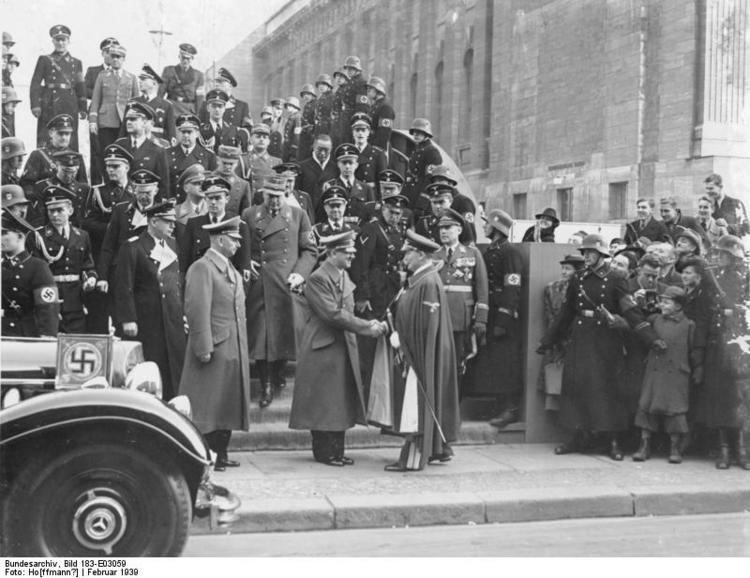Role Bodyguards | ||
 | ||
Active 29 February 1932 – 30 April 1945 | ||
SS-Begleitkommando des Führers ("SS Escort Command of the Führer"), later known as the Führerbegleitkommando (Führer Escort Command; FBK) was originally an eight-man SS squad formed from a twelve-man security squad (known as the SS-Begleitkommando) tasked with protecting the life of Adolf Hitler during the early 1930s. It was expanded and remained responsible for Hitler's personal protection until 30 April 1945.
Contents
Service history
The SS-Begleitkommando was formed on 29 February 1932 to provide general protection to Hitler and other party functionaries. Twelve SS members were selected by Sepp Dietrich to present to Hitler. From the twelve, a smaller eight-man team called the SS-Begleitkommando des Führers was chosen to protect Hitler as he travelled around Germany. Their first appearance was when they accompanied Hitler during the election campaign trips in 1932. They served around the clock protecting Hitler.
In the spring of 1934, the Führerschutzkommando (FSK) replaced the SS-Begleitkommando des Führers for Hitler's overall protection throughout Germany. The small SS-Begleitkommando des Führers unit continued to provide personal security for Hitler. The FSK was also responsible for general security measures, preventive measures, and prosecution of assassination attempts. The Führerschutzkommando was officially renamed the Reichssicherheitsdienst (Reich Security Service; RSD) on 1 August 1935. The RSD and the SS-Begleitkommando cooperated with the Ordnungspolizei (uniformed order police), Gestapo, and other agencies to provide the inner security requirements, whereas outer protection was handled by general SS units.
Expansion and renamed
Later the SS-Begleitkommando was expanded and became known as the Führerbegleitkommando (Führer Escort Command; FBK). The FBK continued under separate command and to provide the close, personal security for Hitler, alone. The additional members for the FBK were drawn from 1st SS Panzer Division Leibstandarte SS Adolf Hitler (LSSAH). Hitler used them for guard duty, but also as orderlies, valets, waiters, and couriers. Although the FBK was administratively under the control of the LSSAH, they received their orders directly from Hitler and in the last years from his chief adjutant, Julius Schaub.
When on duty, the FBK members were the only armed personnel Hitler allowed to be near him. They never had to surrender their Walther PPK 7.65 pistols and were never searched when they were with Hitler. The FBK and RSD worked together for security and protection during trips and public events, but they operated as two groups and used separate vehicles. Johann Rattenhuber, chief of the RSD, was in overall command and the current FBK chief acted as his deputy. By March 1938, both units wore the standard field grey uniform of the Schutzstaffel (SS). Both units were under the control of the SS and both units were made up of SS members. The RSD uniform had the Sicherheitsdienst (SD) diamond on the lower left sleeve.
The FBK accompanied Hitler on all his travels and was always present at the different Führerhauptquartiere (Führer Headquarters) located in various parts of occupied Europe during World War II. Wherever Hitler was in residence, members of the FBK and RSD would be present. The RSD men patrolled the grounds and the FBK men provided close security protection. For special events, the number of LSSAH guards, which provided an outer ring of protection were increased. By June 1941, the FBK had grown to 35 members. Later by 15 January 1943 it had expanded to 31 SS officers and 112 men. Thirty-three were used in escort duties, rotating in groups of eleven. The rest were used as guards for Hitler's residence and as drivers, orderlies, valets, waiters, couriers and for communication duties. The term Begleit-Kommando or Begleitkommando-SS were used at times when referring to the Führerbegleitkommando.
The last FBK commander was SS-Obersturmbannführer Franz Schädle, who was appointed on 5 January 1945, after the dismissal of Bruno Gesche. Thereafter, Schädle and the FBK accompanied Hitler (and his entourage) into the Führerbunker complex under the Reich Chancellery garden in the central government sector of Berlin. By 23 April 1945, Schädle commanded approximately 30 members of the unit who stood guard for Hitler until his suicide on 30 April 1945.
Original members
Commanders
RSD Commander:
SS-Begleitkommando (later known as: FBK) Commanders:
